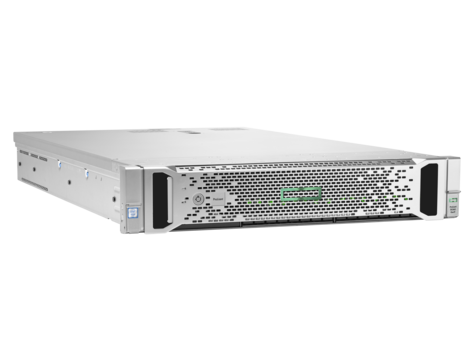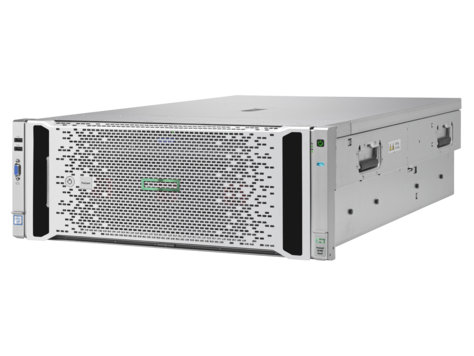گلوگاه سرور شما کجاست؟ در بخش پردازش یا ذخیرهسازی داده؟ HP با در نظر گرفتن هر دو رویکرد فوق نسل هشتم مدل DL380 خود را ارائه کرده است. این مدل ویژه راهحلی منطقی و جامع برای انجام محاسبات سنگین تا ذخیرهسازی دادههای مهم است. شرکت HP از سالها پیش به منظور رفع نیازهای واحدهای تجاری کوچک مدلهای DL380 خود را با انعطافپذیری بالا ارائه کرده است.

ماهان شبکه ایرانیان - خرید سرور HP
ماهان شبکه ایرانیان مرکز فروش خرید وقیمت تمام سرور های اچ پی ای نیو و دست دوم و استوک اماده میباشد خرید سرورDL 380 G10 نسل جدید سرور اچ پی
ماهان شبکه ایرانیان - خرید سرور HP
ماهان شبکه ایرانیان مرکز فروش خرید وقیمت تمام سرور های اچ پی ای نیو و دست دوم و استوک اماده میباشد خرید سرورDL 380 G10 نسل جدید سرور اچ پیقیمت خرید و فروش سرور اچ پی قیمت سرور اچ پی سرور hp
قیمت خرید و فروش سرور اچ پی قیمت سرور اچ پی سرور hp
معرفی سرور HP ProLiant DL560 Gen9
معرفی سرور HP ProLiant DL560 Gen9

اگر
به دنبال سروری کوچک ،DL560 چابک و با سرعت پردازشی بسیار بالایی هستین ،
انتخاب درستی داشته این . DL560 یکی از سرور های جدید خانواده پرولیانت
کمپانی HP میباشد که در کنار قدرت بالا ، از سایز و حجم کمی برخوردار است و
فضای 2U از رک شما را اشغال خواهد کرد .
این سرور DL560 از سری پردازنده های قدرتمند و بهینه Intel® Xeon® E5-4600 v3 شرکت اینتل بهره می برد .DL560 ولی در مقایسه با سرور DL580 G9 قدرت پردازش و مانور کمتری دارد . فلذا برای شرکت های کوچک انتخابی ایدهآل می باشد . اما در زمینه پشتیبانی از شیار توسعه کارت حافظه نصف سرور DL580 می باشد . به طوری که از 48 شایر توسعه با ظرفیت 3ترابایت را پشتیبانی می کند .
DL560 اما در سایر مشخصات تقریبا مشابه هم خانواده های خود می باشد . تفاوت زیادی نمی کند .
اطلاعات بیشتر در سایت HPE.com
این سرور DL560 از سری پردازنده های قدرتمند و بهینه Intel® Xeon® E5-4600 v3 شرکت اینتل بهره می برد .DL560 ولی در مقایسه با سرور DL580 G9 قدرت پردازش و مانور کمتری دارد . فلذا برای شرکت های کوچک انتخابی ایدهآل می باشد . اما در زمینه پشتیبانی از شیار توسعه کارت حافظه نصف سرور DL580 می باشد . به طوری که از 48 شایر توسعه با ظرفیت 3ترابایت را پشتیبانی می کند .
DL560 اما در سایر مشخصات تقریبا مشابه هم خانواده های خود می باشد . تفاوت زیادی نمی کند .
اطلاعات بیشتر در سایت HPE.com
سرور HP ProLiant DL560 Gen9
معرفی سرور HP ProLiant DL560 Gen9

اگر
به دنبال سروری کوچک ،DL560 چابک و با سرعت پردازشی بسیار بالایی هستین ،
انتخاب درستی داشته این . DL560 یکی از سرور های جدید خانواده پرولیانت
کمپانی HP میباشد که در کنار قدرت بالا ، از سایز و حجم کمی برخوردار است و
فضای 2U از رک شما را اشغال خواهد کرد .
این سرور DL560 از سری پردازنده های قدرتمند و بهینه Intel® Xeon® E5-4600 v3 شرکت اینتل بهره می برد .DL560 ولی در مقایسه با سرور DL580 G9 قدرت پردازش و مانور کمتری دارد . فلذا برای شرکت های کوچک انتخابی ایدهآل می باشد . اما در زمینه پشتیبانی از شیار توسعه کارت حافظه نصف سرور DL580 می باشد . به طوری که از 48 شایر توسعه با ظرفیت 3ترابایت را پشتیبانی می کند .
DL560 اما در سایر مشخصات تقریبا مشابه هم خانواده های خود می باشد . تفاوت زیادی نمی کند .
اطلاعات بیشتر در سایت HPE.com
این سرور DL560 از سری پردازنده های قدرتمند و بهینه Intel® Xeon® E5-4600 v3 شرکت اینتل بهره می برد .DL560 ولی در مقایسه با سرور DL580 G9 قدرت پردازش و مانور کمتری دارد . فلذا برای شرکت های کوچک انتخابی ایدهآل می باشد . اما در زمینه پشتیبانی از شیار توسعه کارت حافظه نصف سرور DL580 می باشد . به طوری که از 48 شایر توسعه با ظرفیت 3ترابایت را پشتیبانی می کند .
DL560 اما در سایر مشخصات تقریبا مشابه هم خانواده های خود می باشد . تفاوت زیادی نمی کند .
اطلاعات بیشتر در سایت HPE.com
برچسبها: HP ProLiant DL560 Gen9، سرور HP ProLiant DL560 Gen9، قیمت سرور، فروش سرور، خرید سرور دست دوم، نمایندگی سرور ایران، نمایندگی سرور
معرفی سرور HP ProLiant DL580 Gen9
معرفی سرور HP ProLiant DL580 Gen9

شاید
بتوان این سرور DL580 G9 را یکی از قدرتمند ترین سرور های HP سرور DL580 G9 در رده ی سرور های
رکمونت خانواده پرولیانت شمرد . سرور DL580 G9DL580 با مشخصات بسیار خوب خود همواره
یکی از ایده آل های مدیران فناوری شرکت ها و سازمان ها بوده و با داشتن آن
همواره خیال آسوده ای را در قبال انجام کارها و پردازش های سنگین خواهد
داشت و هیچ وقت دغدغه ی کندی شبکه و قطعی های پی در پی و هنگی ارتباطات را
نخواهند داشت. ولی در کنار مشخصات و مزایای بسیار خوب این دستگاه ، شرکت HP
قیمت نسبتا بالایی را هم برای این سرور در نظر گرفته است . سرور DL580 G9 این قیمت شاید
در نگاه اول بسیار بالا باشد ولی اگر کمی با سخت افزار تعبیه شده در آن
آشنا شویم ، قیمت آن بسیار معقولانه تر خواهد بود .
این سرور DL580 G9 با بهره گیری از پردازنده های نسل سوم خانواده های Intel® Xeon® E7-8800 و Intel® Xeon® E7-4800 قدرتی فرازمینی دربرابر هر محاسبه و عملیات سنگین رایانه ای خواهد داشت . این سرور DL580 G9 در مقایسه با سایر هم خانواده های خود قابلیت نصب چهار پردازشگر را دارا می باشد که شاید یکی از مزیت های دیگر آن در مقایسه با قیمت بالای آن همین ظرفیت پشتیبانی از چهار پردازشگر قدرتمند باشد .
اما همواره در آن سوی محاسبات ،سرور DL580 G9 در کنار داشتن چنین قدرت پردازشی بالا نیاز به حافظه ی رم با ظرفیت بالا نیز میباشد . این نیاز را نیز متخصصین HP به آسانی پاسخ داده اند و با بکار گیری 96 شیاف درگاه توسعه حافظه و حداکثر ظرفیت 3ترابایت دیگر حرفی برای گفتن باقی نگذاشته اند .
از سایر مزیت های این سرور DL580 G9 قدرتمند می توان به توانایی بهره مندی از 10 محل برای قرارگیری هارد های SFF از نوع SAS/SSD اشاره کرد . همچنین پشتیبانی از نسل جدید کارت شبکه های FLR ار بایستی به امکانات این غول جدید کمپانی HP اشاره کرد .سرور DL580 G9
ادامه مطلب ...
این سرور DL580 G9 با بهره گیری از پردازنده های نسل سوم خانواده های Intel® Xeon® E7-8800 و Intel® Xeon® E7-4800 قدرتی فرازمینی دربرابر هر محاسبه و عملیات سنگین رایانه ای خواهد داشت . این سرور DL580 G9 در مقایسه با سایر هم خانواده های خود قابلیت نصب چهار پردازشگر را دارا می باشد که شاید یکی از مزیت های دیگر آن در مقایسه با قیمت بالای آن همین ظرفیت پشتیبانی از چهار پردازشگر قدرتمند باشد .
اما همواره در آن سوی محاسبات ،سرور DL580 G9 در کنار داشتن چنین قدرت پردازشی بالا نیاز به حافظه ی رم با ظرفیت بالا نیز میباشد . این نیاز را نیز متخصصین HP به آسانی پاسخ داده اند و با بکار گیری 96 شیاف درگاه توسعه حافظه و حداکثر ظرفیت 3ترابایت دیگر حرفی برای گفتن باقی نگذاشته اند .
از سایر مزیت های این سرور DL580 G9 قدرتمند می توان به توانایی بهره مندی از 10 محل برای قرارگیری هارد های SFF از نوع SAS/SSD اشاره کرد . همچنین پشتیبانی از نسل جدید کارت شبکه های FLR ار بایستی به امکانات این غول جدید کمپانی HP اشاره کرد .سرور DL580 G9
سرور کامل اچ پی
ex VAT
Verdict
The new
ProLiant DL380p Gen8 is capable of taking on a wide range of rolDL380 SERVER HPes in
the datacentre as it has versatility as its middle name. Storage
capacity and expansion potential are very good and HP’s iLO4 and its new
remoteDL380 SERVER HP management strategy really make this server stand out.
With its latest Gen8 ProLiant serve
